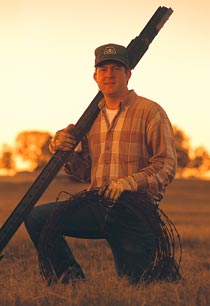Keeping ‘Em Down On The Farm

The good life, or a good living? That’s the choice it comes down to today for young folks who want to farm, said Bill Hardy, associate agriculture dean at Auburn University. And for the vast majority of them, when they look at the economic realities, the desire to make a decent living wins out. They forgo farming and opt for more financially rewarding, non-farm careers.Consider, for instance, USDA statistics showing that, in 2000, a mere 4 percent–just $2,598–of the average farm family’s household income came from farming.”Even with a very strong love for the agrarian way of life, it would be difficult for an ambitious and intelligent young man or woman today to be satisfied with the difference in earnings potential that off-farm jobs provide,” Hardy told the audience at the recent Butler/Cunningham Conference on Agriculture and Economics in Birmingham. For most young people who desire to farm, Hardy said, it comes down to weighing the benefits of farm life against realistic economic goals. Do the easy-going lifestyle, the independence of working for oneself, the opportunity to be outdoors and watch things grow, and the wholesome environment in which to raise children outweigh financial security and stability and providing a comfortable lifestyle?”Those latter goals and desires conflict with the goals and desires that would keep us on the farm,” Hardy said. “When we look at these conflicts, we begin to understand the importance of some of those basic principles we learned in economics and finance. Basically, it comes down to this: If we want to have things, income is a necessity, and that income can’t always be found on the farm.”In his presentation, “How Ya Gonna Keep ‘Em Down on the Farm, Given Today’s Economic Perspective?” Hardy said the only way young farm folks are able to ensure a reasonable household income is if one or both spouses have off-farm jobs. That presents a problem in many rural areas, though, because when there is little or no industry and there are no major cities nearby, employment prospects are few. Thus sets in motion what Hardy called the “out-migration cycle” that plagues rural Alabama and rural America today.”The initial loss and lack of jobs in the farm economy starts the first wave of loss of population, especially the productive young people,” Hardy said. “And as those folks move out, the population in these areas gets older, the death rate begins to exceed the birth rate and the local population declines even more.”Subsequently, as the tax base shrinks, key government, business, social and religious functions soon are no longer viable, and all public and private investment in the area eventually dries up, which leads to further loss of jobs and continued out-migration.”Once out-migration from an area begins, the cycle usually will continue until that area completely dies,” Hardy said. A massive out-migration in the nation’s heartland has prompted Sen. Byron Dorgan (D-N.D.) and Sen. Chuck Hagel (R-Neb.) to sponsor the New Homestead Economic Opportunity Act (S1860), a bill which, though not expected to pass this year, would create government incentives to entice highly productive individuals as well as businesses to return to the rural, out-migration areas and stop the cycle.”Then you’d have more jobs off the farm available, and that’s what it takes today to stay on the farm: somebody working off the farm,” Hardy said. Shrinking farm numbers in recent decades has robbed the majority of young people of the experience of growing up on a farm, and that means several longstanding ag education programs are more crucial than ever in maintaining an understanding of and an interest in agriculture, Hardy said. “It is absolutely necessary that emphasis be increased on FFA, 4-H, Ag in the Classroom and Farm-City Week programs so that more of our population can understand the agricultural industry and the problems the production sector faces today,” Hardy said. “The public must understand how relative this is to them, that if current trends continue, they may not be able to continue enjoying the relatively inexpensive and abundant food and fiber supply they have today.”
